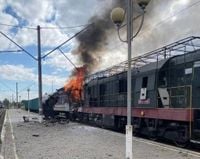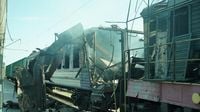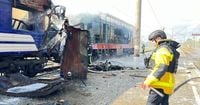In the early hours of October 4, 2025, the quiet of Shostka, a city in Ukraine’s Sumy region near the Russian border, was shattered by a devastating Russian drone strike. The attack targeted a bustling railway station, striking two passenger trains in quick succession and leaving a trail of destruction, grief, and renewed international alarm. At least 30 civilians were injured, including three children, and a 71-year-old man lost his life when he was found in one of the scorched carriages, according to regional prosecutors and multiple reports from Reuters and The Associated Press.
Ukrainian President Volodymyr Zelenskyy did not mince words in his condemnation, describing the event as a “savage” act of terror. In a post on X (formerly Twitter), Zelenskyy declared, “Every day Russia takes people’s lives. And only strength can make them stop.” He further urged the international community to move beyond rhetoric, stating, “We’ve heard resolute statements from Europe and America – and it’s high time to turn them all into reality, together with everyone who refuses to accept murder and terror as normal. Lip service is not enough now. Strong action is needed.”
The strike unfolded in a chilling sequence. According to Oleksiy Kuleba, Ukraine’s deputy prime minister and reconstruction minister, the first drone targeted a local commuter service. As rescue efforts began and passengers were being evacuated, a second drone struck a Kyiv-bound train nearby—a tactic known as a “double tap,” infamous for hitting first responders and evacuees. Ukraine’s Foreign Minister Andrii Sybiha underscored the deliberate nature of the attack, saying Moscow had intentionally targeted civilians during the operation.
Oleksandr Pertsovsky, head of Ukraine’s national rail operator Ukrzaliznytsia, called the incident “a vile attack aimed at stopping communication with our front-line communities.” The strikes severed vital rail connections near the Russian border, affecting towns and villages already strained by war. The aftermath was captured in harrowing images posted by Zelenskyy and local governor Oleh Hryhorov, showing passenger carriages still ablaze, thick plumes of smoke billowing into the sky.
But the railway strike was only part of a broader escalation. Over the past two months, Russia has intensified its campaign against Ukraine’s rail and power infrastructure, launching near-daily attacks as winter approaches. Ukrainian officials have accused Moscow of attempting to weaponize the cold by targeting facilities that provide heat, light, and running water—an echo of previous years since Russia’s full-scale invasion began on February 24, 2022.
Just hours before the Shostka attack, Russian drones and missiles pummeled Ukraine’s power grid overnight, causing blackouts for 50,000 households near the border, according to utility supplier Chernihivoblenergo. The strikes damaged energy facilities near Chernihiv, west of Shostka, and sparked fires that left entire communities in darkness. Roman Andarak, Ukraine’s Deputy Minister of Energy, remarked, “It’s an obvious attempt to deprive Ukrainians of light and heat in the autumn-winter period. The Russians did not give up the intentions of plunging Ukraine into darkness on the eve of the new heating season.”
The campaign against Ukraine’s energy sector reached a new peak on October 3, when Russia launched its largest attack yet on the country’s main gas production facilities in Kharkiv and Poltava regions. According to Naftogaz CEO Serhii Koretskyi, 60 drones and 35 missiles targeted the state-owned company’s infrastructure in an assault described as the biggest since the war began. Ukrainian Prime Minister Yulia Svyrydenko was unequivocal in her assessment: “Russia seeks to terrorize civilians and undermine our energy security on the eve of the heating season. It will not succeed.” Koretskyi echoed these sentiments, insisting the attacks had no military purpose, only to inflict suffering on civilians.
Elsewhere in Ukraine, violence continued to ripple outward. On the same day as the Shostka strike, a Russian drone hit a fishing boat near the border, killing a 63-year-old man and injuring his 65-year-old companion, local prosecutors reported. And in the war-torn Donbas region, French photojournalist Antoni Lallican was killed by a Russian drone strike near Druzhkivka while reporting from the front lines. Lallican, 37, had been nominated for the RSF press photography award in 2024 and became the 14th reporter—and fourth French national—to die covering Russia’s invasion. His Ukrainian colleague, Hryhory Ivanchenko, was injured in the same attack.
The repercussions of Russia’s drone warfare are being felt far beyond Ukraine’s borders. On October 4, European Union officials convened in Munich to discuss drone defense, as a spate of drone sightings forced temporary shutdowns at airports and military installations across Germany. Munich Airport, for instance, was closed twice in two days, disrupting travel for thousands. The Kremlin, for its part, has denied involvement in these incidents, though NATO has grown increasingly alarmed by drone incursions and airspace violations in member states like Poland and Estonia. In response, Polish and allied air defenses have been deployed to secure national airspace, with the Polish military calling the measures “preventive” amid the ongoing Russian air assault on Ukraine.
Meanwhile, the conflict’s impact on critical infrastructure has raised concerns about nuclear safety and international aviation. The International Atomic Energy Agency (IAEA) has called for renewed political will to protect the Russian-held Zaporizhzhia nuclear power plant, which has been cut off from external power since late September. The United Nations aviation agency, ICAO, has also rebuked Russia for disrupting satellite navigation systems, following complaints from Estonia and Finland about GPS jamming—a charge Moscow denies.
Despite the onslaught, Ukrainian forces continue to mount their own counterattacks. On October 4, the Ukrainian military reported that it had struck the Kirishi oil refinery near St. Petersburg, one of Russia’s largest, causing explosions and a fire. Russian officials said seven drones were shot down near Kirishi, and a fire in the industrial zone was extinguished. Russia, the world’s second-largest oil exporter, recently paused gasoline exports after a seasonal demand spike and repeated Ukrainian strikes led to shortages.
All the while, the scale of drone warfare has escalated to staggering levels. The Russian Defense Ministry claimed to have shot down 117 Ukrainian drones overnight, with at least 37 more intercepted the following day. Ukrainian officials reported that Russian forces launched 109 drones and three ballistic missiles during the same period, underscoring the relentless pace and growing complexity of the conflict.
The events of October 4, 2025, stand as a stark reminder of the human toll and infrastructural devastation wrought by modern warfare. As Ukraine braces for another harsh winter under fire, the world watches, debates, and—Ukrainian leaders hope—prepares to act.






